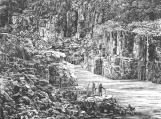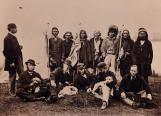1
Simon Fraser visited "Kumcheen" in 1808, on his expedition to find a route to the West Coast of North America. This was the beginning of an increase in trade for the local inhabitants and the settlement of "The Forks" by Europeans.2
A sketch showing First Nation people with salmon drying racks.4 May 1872
At Hell's Gate on the Fraser River

3
During the first years after contact, the First Nation peoples established trade with the Europeans, and helped move supplies through the Fraser Canyon by foot and canoe, along their established routes. The interior of the territory was slowly opened up and explored and, as the natural outlet of the 'funnel' of the Fraser Canyon, Lytton was settled by Europeans.5
Locally made baskets gradually changed from being practical items to a trade commodity.Each basket maker had their own special designs and the origin of baskets in many collections can be traced by identifying these designs.
6
Two examples of traditional Lytton baskets.21 October 2004
Taken at the Lytton Museum and Archives

7
With the Europeans came metal. These root diggers show the integration of the now common iron into every day life.8
Traditional root digging tools with metal shafts.21 October 2004
Taken at the Lytton Museum and Archives

